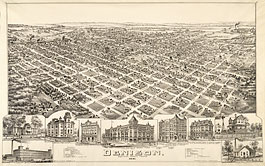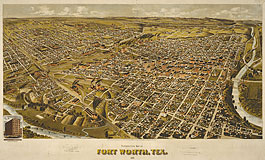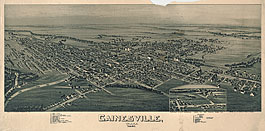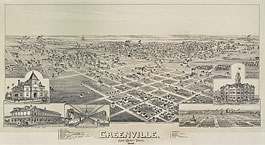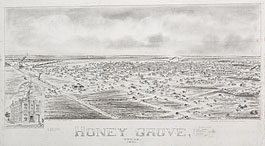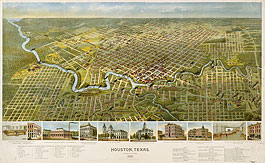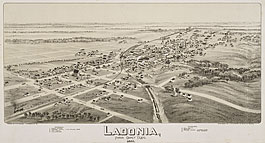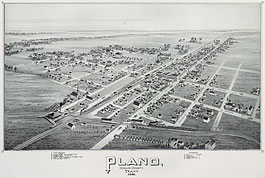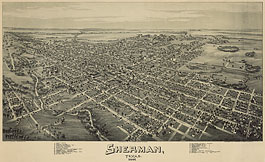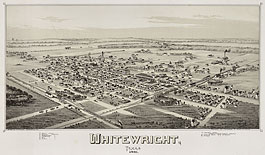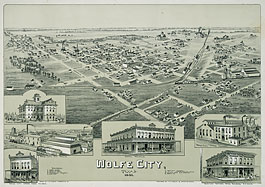Denison in 1891
Thaddeus Fowler perhaps began his second tour of Texas with his picture of Denison, a growing city with a population approaching 11,000 by 1891. On January 11, The Sunday Gazetteer reported that the artist had been in the city for several weeks making pencil sketches for the new bird’s-eye view, which would be much larger than previous views of the city. “It is believed to include every residence within… [More]
Fort Worth in 1891
The fact that Henry Wellge was back in Fort Worth in 1891 to revise his 1886 view demonstrates the concern the city fathers had in promoting the city, as they tried to recover from the difficult economic conditions. Again depicting the city from the northeast, Wellge showed the same basic area as in the 1886 print, suggesting that he might have used the earlier print as a pattern for… [More]
Gainesville in 1891
Gainesville continued to grow in the years between Augustus Koch’s visit in 1883 and Thaddeus Fowler’s in 1891, due partly to the arrival of two additional railroads: the Santa Fe in 1886 and the Gainesville, Henrietta and Western Railway in 1887. Almost 6,600 persons called the city their home by 1890, perhaps double the population of 1883. Unlike some communities that suffered when the trail drives came to an… [More]
Greenville in 1891
For a city that waited longer than most for the railroad, Greenville had become a rail center by the time of Fowler’s visit in 1891. In addition to the Missouri, Kansas and Texas, the East Line and Red River, and the Dallas and Greenville railways, the St. Louis Southwestern arrived in 1887 and the Texas Midland in 1896, five years after Fowler’s view. Hunt County was no longer an… [More]
Honey Grove in 1891
Fowler included Honey Grove in his 1891 tour of North Texas and produced an elaborate drawing of the city, highlighted with blue pencil and wash, but there is no record that it was ever lithographed. Perhaps the economic situation had worsened for Honey Grove merchants and farmers since Henry Wellge’s 1886 visit; or perhaps they believed that Wellge’s handsome lithograph had not paid sufficient dividends and were unwilling to… [More]
Houston in 1891
A. L. Westyard’s view of Houston in 1891 documented the city as it began a decade of explosive growth—in population, growing from 27,557 in 1890 to 44,633 in 1900, as well as in area, with suburbs such as Magnolia Park appearing beyond the jurisdictional reach of the City Council but made convenient to the city center by rail transportation. Houston in the 1890s came face-to-face with the advantages and… [More]
Ladonia in 1891
The population of Ladonia, in the southeastern corner of Fannin County, numbered around 1,000 when Fowler visited in 1891 to make this view of the city. It is doubtful that there would have been a sufficient market for Fowler’s views among so few citizens themselves, in Ladonia or any of the other small towns that the bird’s-eye view artists documented. Perhaps several entrepreneurs or city officials took it upon… [More]
Plano in 1891
Plano is known today as a suburb of Dallas, completely engulfed by the larger city along with other nearby communities. But in 1891 when Fowler made this view, Plano stood separate and apart, with an economy that had begun to develop as a result of the arrival of the railroads in the previous decades. The first Anglo-American settlers in Collin County, prior to the Civil War, engaged mainly in… [More]
Sherman in 1891
The Texas Legislature established Sherman as the seat of government for Grayson County in 1846, and by 1860 the city had incorporated and become an important trading center for farmers in the surrounding area. The growth continued with the arrival of the Houston and Texas Central Railway in 1872, but because the city did not offer enough support, the Missouri, Kansas and Texas line chose to establish a new… [More]
Whitewright in 1891
Like many other Texas cities, Whitewright owes its founding to the arrival of the railroad and the westward movement of cotton production out of deep East Texas. In 1878, as the Missouri, Kansas and Texas Railroad was making its way into the state, New York investor William Whitewright purchased a tract of land in the railroad’s right-of-way. He surveyed a town site and then brought in agents to conduct… [More]
Wolfe City in 1891
Wolfe City was founded in the late 1860s or early 1870s when J. Pinckney Wolfe built a mill near Oyster Creek in north-central Hunt County. For a while it was known as Wolfe’s Mill, but by the time it received a post office, the name had been changed to Wolfe City. Adding “city” to the name was an affectation that dozens of small towns in Texas and across the… [More]











